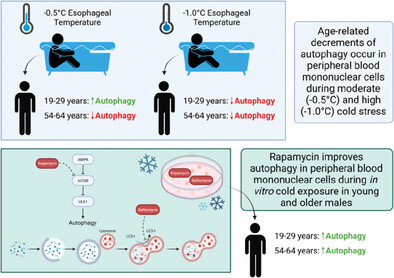This is a summary with a specific master prompt, generated by Gemini AI. I had to ask Grok4-fast the forum format, which appears to be based on Discourse, then asked Gemini to transcribe the answer in a suitable manner. The second time around it seems to be better off. I find it is a frequent an issue to transcribe from the chatbox to the forums.
A specialized code format, such as Discourse BBCode or Markdown, is the most appropriate way to transcribe complex, structured information for a forum like rapamycin.news. Since Discourse primarily uses Markdown, I’ll provide the previous analysis in that format, optimizing it for forum readability with the inclusion of color and emphasis.
I apologize for the presence of the LaTeX math symbols (e.g., $\mathbf{10-15^{\circ}\text{C}}$, CD56$^{\text{lo}}$CD16$^+$) within the standard Markdown format, as they are not properly rendered without a LaTeX interpreter.
Here is the revised transcription in clean Markdown, with all mathematical notation converted to simple text for maximum compatibility on a Discourse forum.
[center] The Effects of Cold Exposure on the Immune System: A Longevity Perspective
The Effects of Cold Exposure on the Immune System: A Longevity Perspective  [/center]
[/center]
Executive Summary for the Longevity Enthusiast
The long-held belief that moderate cold exposure depresses the immune system is not supported by current evidence. Deliberate, short-term cold stress (a form of hormesis) is highly likely ($\sim 70-80%$ probability) to be beneficial. It primarily works by:
-
Activating the Sympathetic Nervous System (SNS), which causes a surge of catecholamines (norepinephrine/epinephrine).
- Causing a rapid, transient mobilization of immune cells (Natural Killer cells and Cytotoxic T-cells) into the bloodstream, enhancing immune surveillance.
- Promoting an anti-inflammatory response through increased Interleukin-10 (IL-10).
1. Mechanisms of Immune Modulation
Cold exposure is a significant physiological stressor that triggers the “cold shock response” and acts as a hormetic stimulus.
-
Mobilization of Immune Cells: The surge in catecholamines acts on beta-2-adrenoreceptors on immune cells, causing a massive redistribution of leukocytes (white blood cells) from storage sites (like the spleen) into the circulation. This is observed as a temporary increase in crucial cells for fighting pathogens and malignant growth:
-
Natural Killer (NK) cells (specifically the cytotoxic subset).
-
CD8$^+$ Cytotoxic T-cells.
This transient mobilization is interpreted as boosting immune surveillance (Source 1.1, 4.1).
-
Anti-inflammatory Effect: Studies, particularly those involving controlled breathing techniques alongside cold (like the Wim Hof Method), show that voluntary SNS activation leads to a significant increase in the anti-inflammatory cytokine Interleukin-10 (IL-10) and a dampening of pro-inflammatory cytokines (TNF-alpha, IL-6, IL-8). This suggests a potential therapeutic effect for conditions characterized by excessive chronic inflammation (Source 3.3, 3.4).
-
Cellular Resilience: Repeated cold acclimation has been shown to improve autophagic function, the cell’s “recycling system,” which is a critical protective mechanism strongly linked to cellular longevity and stress resistance (Source 2.2).
2. Recommended Protocols: Water vs. Air
Optimal parameters are not definitively fixed, but consensus suggests the following effective ranges:
A. Cold Water Immersion (CWI) / Cold Showers
| Parameter |
Recommended Protocol |
Technical Rationale |
| Temperature |
10-15°C (50-59°F); Colder means shorter duration. |
Used to elicit the strong ‘cold shock’ and catecholamine surge. The key is to be uncomfortably cold, but safe (Source 5.1). |
| Duration (Per Session) |
1-5 minutes. |
Brief exposure is enough to trigger the neuroendocrine and immune responses. Start with 30-90 seconds and gradually increase (Source 5.4). |
| Frequency (Weekly Total) |
~11 minutes total per week, across 2-4 sessions. |
This is suggested as a minimum effective dose for sustained benefits (Source 5.4). |
[color=darkgreen]Functional Benefit:[/color] A large-scale narrative review suggests a 29% reduction in sickness absence among participants who regularly took cold showers, indicating a tangible benefit to functional immunity (Source 1.4).
B. Cold Air Exposure (CAE) / Whole-Body Cryotherapy (WBC)
| Parameter |
Recommended Protocol |
Technical Rationale |
| Moderate Cold Air |
16-19°C (60-66°F). |
This sub-shivering temperature range is often used to stimulate Brown Adipose Tissue (BAT) activation, which has downstream metabolic and immune benefits (Source 5.2). |
| WBC |
-110°C to -140°C for 2-4 minutes. |
Extreme cold for very short, intense physiological stress (Source 5.2). |
3. Strategic Timing for Longevity
For a 65-year-old dedicated to healthspan, timing is critical to avoid compromising training gains:
-
 Do it: Early in the day for the catecholamine and alertness boost.
Do it: Early in the day for the catecholamine and alertness boost.
-
 Don’t do it: Within 4-6 hours after strength or hypertrophy training. CWI post-exercise may blunt molecular signaling pathways that drive muscle growth and strength adaptation. Separate the stimuli to maximize both immune benefits and musculoskeletal gains (Source 5.4).
Don’t do it: Within 4-6 hours after strength or hypertrophy training. CWI post-exercise may blunt molecular signaling pathways that drive muscle growth and strength adaptation. Separate the stimuli to maximize both immune benefits and musculoskeletal gains (Source 5.4).
4. Conclusion and Safety
Cold exposure is a powerful, non-pharmacological tool for enhancing resilience and modulating the immune system in a pro-longevity manner.
[color=red]Safety Caveat:[/color] The initial cold shock rapidly and significantly increases heart rate and blood pressure. While generally safe for healthy individuals, those with diagnosed or suspected cardiovascular issues (e.g., uncontrolled hypertension or arrhythmias) should consult a cardiologist before beginning a cold exposure regimen. Always start with a higher, tolerable temperature and a short duration, prioritizing safety over perceived benefits.
